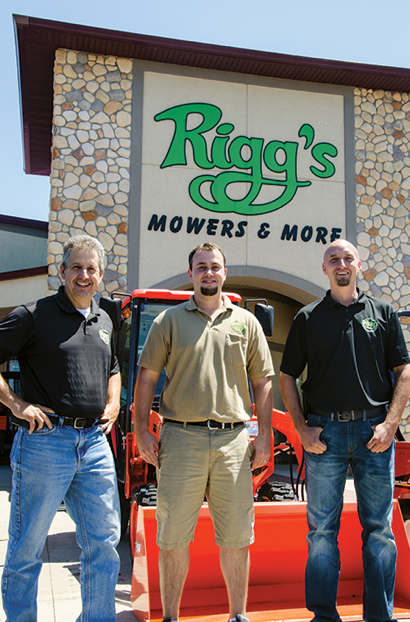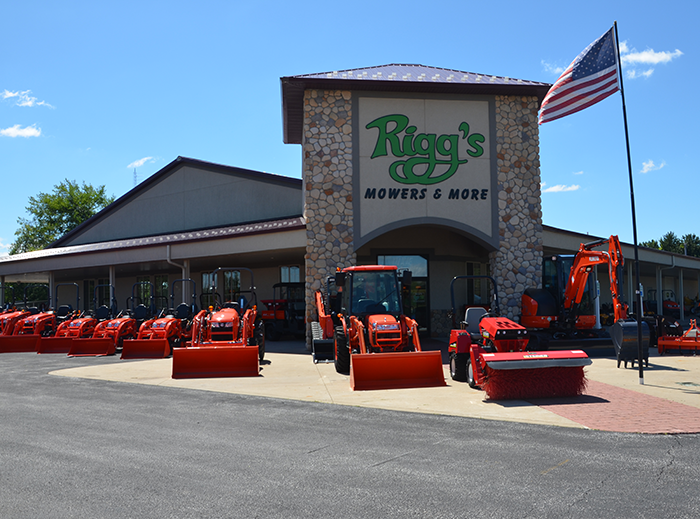Geoff Blanco joined Rigg’s Outdoor Power Equipment in 2003 and shortly after became a part owner, with 49% share of the dealership. Last March, he completed the acquisition of the dealership and shares a first-hand account in Part One of a three-part series.
Rigg’s Outdoor Power Equipment has locations in Valparaiso, Mishawaka, LaPorte and Lafayette, Ind., and carries Kubota, Hustler, Cub Cadet, Stihl, Land Pride, Western, Honda, and Toro consumer equipment. The dealership was featured in our 2014 “Season-to-Season” series and Blanco serves on Rural Lifestyle Dealer’s editorial advisory board.
RLD: Can you set the stage for events leading up to the acquisition?
Blanco: Prior to being in this industry, I was the vice president of sales and marketing for an IT consulting firm, with ownership in the firm during the rise and subsequent fall of the “dotcom” boom. However, my heart was always in my roots of spending a lot of my youth on the family farm. When I decided to make a career change, it came with some big personal changes, but I saw a lot of potential in what was then Rigg’s Mowers & More with its two locations.
You're reading Part #1 of the Path to Acquisition article series.
Part #2: How a Partner Became an Owner
In Part #2, Geoff Blanco shares more details about the challenges he faced in acquiring full ownership of Rigg’s Outdoor Power Equipment after being a partner for 12 years.
If you have ownership in any company, or looking to buy a business, you need to have two plans: 1) How are you going to grow the business and 2) how are you going to get out of it financially successful. The first part is critical because if you are not already in the business, you have to increase income enough for the business to afford you. As an owner, your goal is to increase shareholder value, which comes from increasing net income and a strong balance sheet which, ultimately, leads to the second point of transitioning out of the business.
Unfortunately, it’s easy to lose sight of this because as a small business owner, we get caught up in the day-to-day activities of keeping the doors open, paying the bills, managing employees, etc.

|
| The Rigg’s Outdoor Power Equipment team includes owner Geoff Blanco (left), Bryon Merritt (center), LaPorte, Ind., location manager, and Jerry Klemczak, Mishawaka location manager. |
What was happening during the time leading up to the closing?
Blanco: It took two years for the process to come to fruition and while that may sound like a long time, it really isn’t for two reasons. The first is that the business has to begin structuring itself for a change in ownership. It’s not just a matter of wanting to sell a business and someone writing a check. Unfortunately, it’s much more complicated than that. The buyer has to procure financing and that world has changed dramatically.
And second, whether it’s someone that owns 100% of the business, or in our case, a split of the business, the seller also has to begin to structure their life outside of the business. When someone has been involved in a dealership for many years, they may think they’re ready to finally retire. But when it comes time to make that transition — for them to not just turn a page in their life, but start a whole new chapter — that takes some time.
Many dealers have been in the business for many, many years and the dealership has defined who they are. They’ve built relationships over the years and it’s tough to let go of that. If you are the buyer, you have to be prepared to deal with this as it may have a significant impact on the timing and structure of your deal.
There is also a lot of retirement planning that the seller has to do, such as working with a wealth management expert, talking with their family and more. The buyer really can’t do much until the seller says, “Yep, I’m ready” and really means it.
How had you been preparing throughout your time as partner to become the sole owner?
Blanco: When I came in as partner, it was my job to grow the business. I had to take an active role in creating shareholder value in a company that was eventually going to be my asset. I took over the majority of sales, marketing and finance to create the business environment that the company needed to get to the next level.
What is one of the first things to consider when acquiring a dealership?
Blanco: The first part of any acquisition — one of the biggest components — is due diligence as this will drive everything else. The most important part of your due diligence will be getting an accurate valuation of the business. This needs to be done by a firm that specializes in this and it won’t necessarily be your accountant. Many dealers use local accountants who are, hopefully, good at what they do but valuations are a special service. In fact, the lenders or buyer will probably not accept a valuation done by the dealer’s accountant as they will be perceived as being too close to the dealer.
Also, keep in mind that you are in a negotiation and the buyer and seller will naturally not agree on what the business is worth. An independent valuation gives a fair market value of the business and will give guidance for how much investment and risk you have. Also, your financing partner is going to require a valuation of their own. They will only lend to the amount of that valuation, so what you can borrow will be limited by that result.
You have to throw out the idea that you’ll just go to the bank to get the money. Since the financial crash in 2008, there are many more regulations and banks have developed a greater risk aversion, especially when it comes to lending to a small business. Banks really don’t want to lend money. They can make more in investment mechanisms than they can with loans, so it’s a “necessary evil” to them these days.
The bank’s salespeople will tell you a different story and will likely be optimistic because that is their job. But the bank’s credit department seems to exist to find a way to not do business with you. Their job is to assess risk and right now, the ratios for what a bank is willing to tolerate are at an all-time high and not in your favor. To further mitigate risks, banks are relying on programs through the Small Business Administration (SBA). This means you have an additional layer of inspections including finances, inventory and insurance. All of this translates into time, effort, and money from you or the seller’s resources if you are not already part of the business.
The lenders will also want an audit of the dealership and will charge you for it. Auditors have the sole job of finding something wrong. They look for skeletons and, unfortunately, many businesses have skeletons in the closet. If the auditors go back to the bank and say that you are 100% clean, the bank doesn’t think they’ve done a thorough job. So, they are going to comb through every aspect of the business and there is no way they are not going to find things that have to be explained.
If you are the buyer of a dealership that you are not already part of, the audit will uncover things you didn’t know and may affect your negotiation position. If you are acquiring a business you are already a part of, it means a lot of frustration because they are going to tell you things about your business you didn’t want to know and will have to clean up before your lender will consider the deal.
Unless you are a buyer that can self-fund the acquisition, the SBA will be involved because it allows banks to outsource the risk to the government. The SBA can be a great resource, but it’s also extremely bureaucratic and understaffed. This means the process is very long and complicated, especially if they find financing or inventory issues or something they don’t like about your dealer agreements. Basically everything you do for the bank you will have to do again for the SBA.
What about a dealership’s manufacturers and the role they play in the acquisition?
Blanco: The manufacturer component is another critical area. The dealer principal has a signed agreement and you may have other partners who have also signed on. Depending on the manufacturer, the change of ownership process can be a difficult and will include your personal financials, credit history and a business plan.
If the person acquiring the dealership is already part of the business, the transition may go smoother because the manufacturer has already been working with them. If it’s someone they’ve never heard of, an outside entity buying the business, then they will do their due diligence on that person. Depending on the contracts, they may not even make the agreements available to them.
Throughout the process, the dealership is still doing business. Can you comment on what that’s like to manage the business and pursue an acquisition?
Blanco: In my scenario I was already part of the business and essentially doing all the work a seller would normally do if they buyer was from the outside. This makes life much more difficult because while managing the acquisition process you still have your day-job of running your business.
So, the third component of any acquisition is the impact on the operations of the business, the employees and customers — and making sure all those things stay aligned.
You’ve got three substantial “legs of the stool” to make sure everything is working in conjunction and moving forward in the right direction so you have a stable environment for the process to continue.
Blanco share more behind-the-scene details in Part Two of “Path to Acquisition.”






Post a comment
Report Abusive Comment